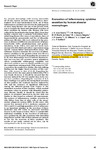Please use this identifier to cite or link to this item:
https://accedacris.ulpgc.es/handle/10553/76864
| Title: | Evaluation of inflammatory cytokine secretion by human alveolar macrophages | Authors: | Losa García, J. E. Rodríguez, F. M. Martín de Cabo, M. R. García Salgado, M. J. Losada, J. P. Villarón, L. G. López, A. J. Pérez Arellano, José Luis |
UNESCO Clasification: | 3202 Epidemologia | Keywords: | Alveolar Macrophage Tumour Necrosis Factor Interleukin-1 Interleukin-6 Interleukin-8 |
Issue Date: | 1999 | Journal: | Mediators of Inflammation | Abstract: | The alveolar macrophage (AM) secretes interleukin 1 beta (IL-1 beta), tumour necrosis factor-alpha (TNF-alpha), interleukin-6 (IL-6) and interleukin-8 (IL-8), all of them inflammatory cytokines involved in the pathogenesis of many lung diseases. The aim of the present work was to evaluate the basal and stimulated secretion of these cytokines by human AMs. Human AMs were collected by bronchoalveolar lavage (BAL) from four healthy controls and 13 patients with diffuse interstitial lung disease (five cases of sarcoidosis, three of hypersensitivity pneumonitis and five of idiopathic pulmonary fibrosis). AMs were cultured in the presence or absence of different concentrations of lipopolysaccharide (LPS), phorbolmyristate and gamma-interferon. IL-1 beta, TNF-alpha, IL-6 and IL-8 levels were measured in BAL fluid and culture supernatant using specific enzyme-linked immunosorbent assays. The substance found to stimulate the secretion of inflammatory cytokines to the greatest extent was LPS at a concentration of 10 mu g/ml. Regarding the secretion of IL-1 beta, four observations were of interest: basal secretion was very low; LPS exerted a potent stimulatory effect; considerable within-group variability was observed; and there were no significant differences in the comparisons among groups. With respect to TNF-alpha secretion, the results were similar. The only striking finding was the higher basal secretion of this cytokine with respect to that of IL-1 beta. Regarding the secretion of IL-6, the same pattern followed by TNF-alpha was found. However it should be stressed that the increase induced by LPS was smaller than in the two previous cytokines. Regarding the secretion of IL-8, three findings were patent: the strong basal secretion of this cytokine; the moderate increase induced by LPS; and the existence of significant differences among the different groups with respect to the stimulated secretion of this cytokine, which reached maximum values in patients with idiopathic pulmonary fibrosis. Finally, it should be noted that the pattern of cytokines observed in the BAL fluid was similar to that found in cultured AM supernatants. The pattern of inflammatory cytokine secretion by AMs differs from that of other cells of the mononuclear phagocyte system (MPS). In this sense. AMs secrete low amounts of IL-1, moderate amounts of TNF-alpha and IL-6, and high quantities of IL-8. Adherence is an important stimulus in the secretion of these molecules and LPS elicits an increased secretion inverse to the basal secretion. There is considerable individual variability in the secretion of inflammatory cytokines by the AMs of patients with interstitial lung disease and the AMs of these patients are primed in vivo for the secretion of these cytokines. The results of our study, carried out in vitro, can be extrapolated to the in vivo setting. | URI: | https://accedacris.ulpgc.es/handle/10553/76864 | ISSN: | 0962-9351 | Source: | Mediators of Inflammation [ISSN 0962-9351], v. 8 (1), p. 43-51, (1999) |
| Appears in Collections: | Artículos |
WEB OF SCIENCETM
Citations
65
checked on Feb 25, 2024
Page view(s)
71
checked on Jan 6, 2024
Download(s)
42
checked on Jan 6, 2024
Google ScholarTM
Check
Share
Export metadata
Items in accedaCRIS are protected by copyright, with all rights reserved, unless otherwise indicated.
